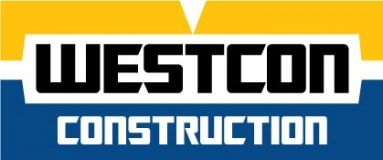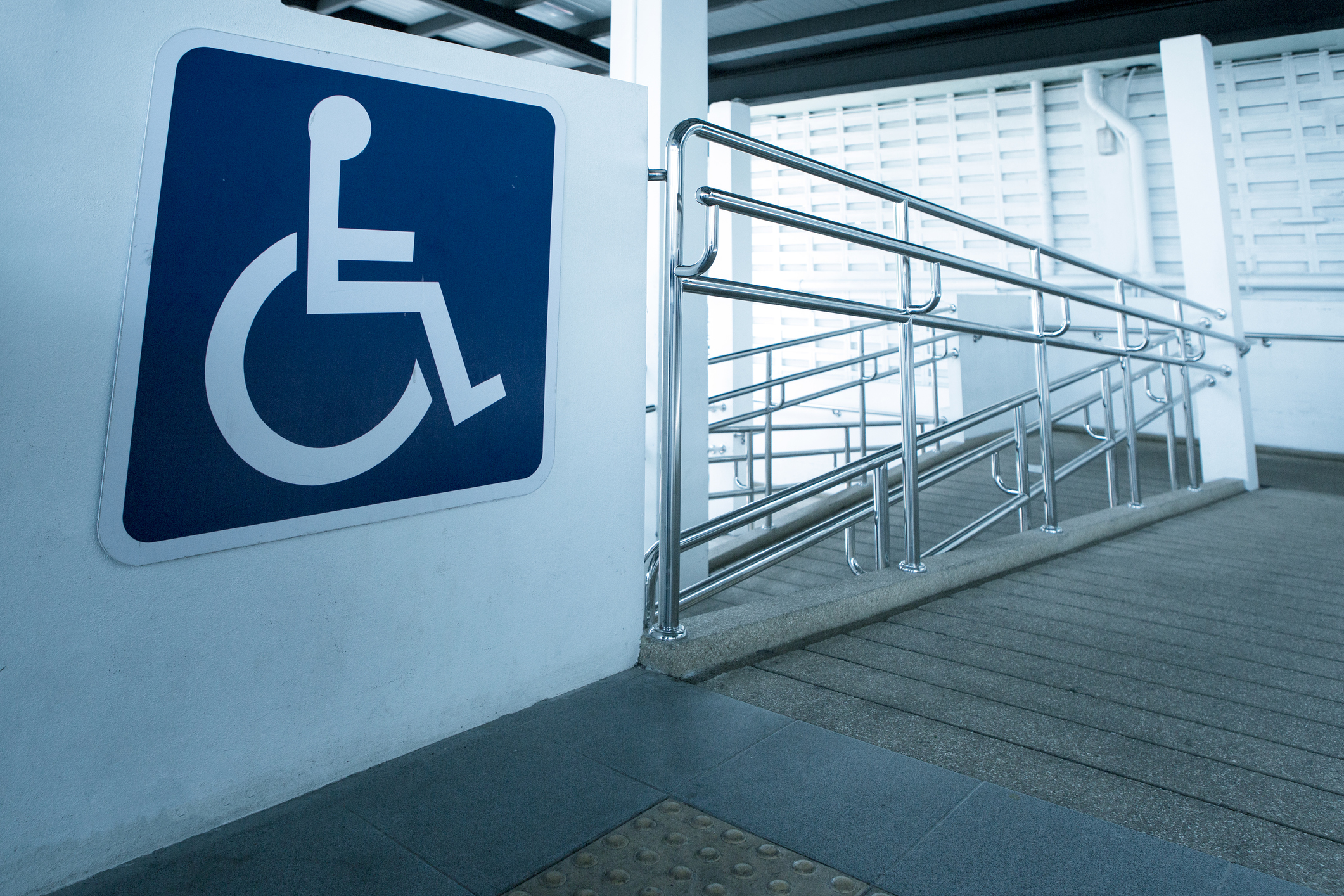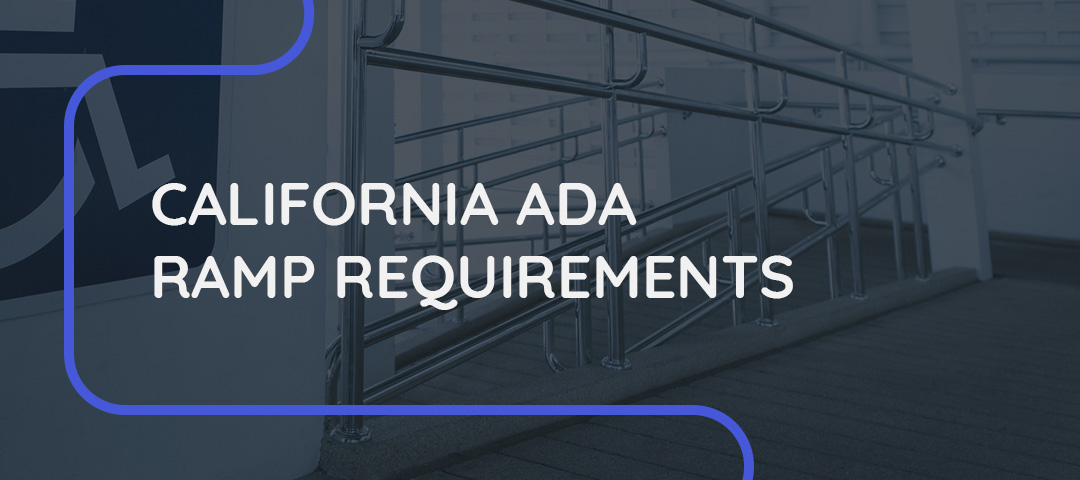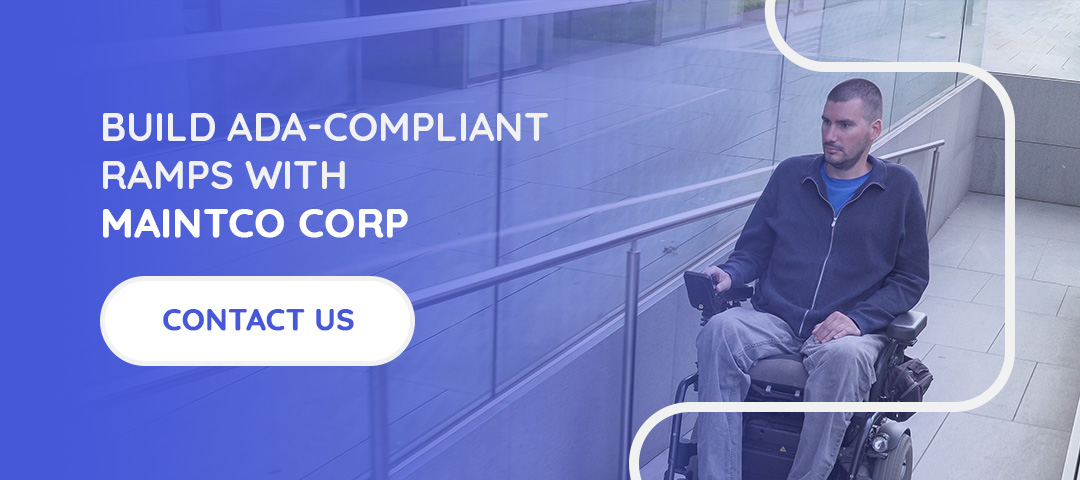California ADA Ramp Requirements
Posted on: February 15, 2022 in ADA ComplianceShare:
California has a high amount of ADA civil lawsuits in the country due to its stringent legislation to protect people with disabilities. Title 24 of California’s Building Code dictates legal requirements for businesses to ensure their facilities are accessible to the majority of the public.
Many businesses ensure their property is ADA-compliant to avoid legal ramifications, but accessible buildings ensure that more people can interact with your company. Companies should strive to build inclusive buildings. While accessible properties meet the minimum legal accessibility requirements, inclusive facilities put the occupants’ experience at the forefront of the design process. Your company can follow universal design principles to make a broader segment of the population feel comfortable in all parts of your building.
Maintco Corp explains what an ADA-compliant ramp is, why accessible ramps are essential and how a construction company can help you build an ADA-compliant ramp for your business.
Table of Contents
- What Are the Ramp Requirements to be ADA-Compliant
- Dangers Of Non-Compliant Ramps
- Build ADA-Compliant Ramps With Maintco Corp
What Are the Ramp Requirements to be ADA-Compliant?
ADA-compliant ramps are implemented indoors and outdoors to ensure your facility is accessible to as many customers as possible. A route requires an ADA-compliant ramp if it has an elevation change of at least half an inch. For example, a curb or a staircase needs an accessible ramp alternative.
A ramp is only ADA-compliant if it adheres to the following requirements:
- ADA Ramp Slope Requirements: Slope refers to the proportion between a ramp’s vertical rise and horizontal length. Any path of travel shall be considered a ramp if its slope is greater than a 1-foot rise in 20 feet of horizontal run. (Title 24, Part 2, Section 2-3306(a)). The maximum slope for an ADA ramp is a 1-foot rise over a 12-foot horizontal stretch. For existing ramps, the slope must not be greater than 8.33%.
- Minimum Width of an ADA Ramp: ADA ramp width requirements stipulate a ramp must be a minimum of 48 inches wide.
- Surface Requirements for Ramps: ADA ramps must be made from nonslip or rough materials that prevent slips in all weather conditions.
- ADA Ramp Rail Requirements: ADA-compliant ramps that rise more than 6 inches above the ground must have handrails mounted on each side. They must be at least 24 to 38 inches above the ramp’s surface and extend 12 inches beyond the ramp. Circular handrails’ maximum diameter should be between 1.25 and 2 inches, while noncircular handrails must have a maximum perimeter between 4 and 6.25 inches. Ramps must also have guide rails when they rise more than 30 inches above the nearby ground.
- Ramp Landing Requirements: A ramp’s landings must be a minimum of 60 inches wide and 60 inches long, and bottom ramps must be at least 72 inches long. ADA ramp landing requirements dictate that a business must provide an intermediate landing when the ramp rises 30 inches above the bottom landing. Intermediate landings that change a ramp’s direction must also be at least 60 inches wide and 72 inches long. Bottom and top landings must also be level and at least as wide as the ramp.
- ADA Curb Ramp Requirements: Urban sidewalks and streets without curb ramps can be dangerous for people with disabilities who use mobility devices. While a curb ramp does not require handrails, it must be at least 48 inches wide with a maximum slope of 8.33%. The top or bottom landing after a curb ramp must also be at least 48 inches long to provide a space for someone who just used a ramp to rest.

Meet ADA Requirements for Ramps with Maintco
Dangers of Not Meeting ADA Ramp Requirements
A noncompliant ramp can be costly for your business. Failing to adhere to ADA ramp guidelines comes with expensive legal fines of up to $4,000 and can harm your company’s reputation. California, Florida and New York are the U.S. states with the most ADA lawsuits. In fact, these three states accounted for more than half of all cases in 2017, with California representing 27% of lawsuits nationwide.
California has stricter legislation to protect people with disabilities than the rest of the nation. The Unruh Civil Rights Act of 1959 and Disabled Persons Act of 2009 safeguard the rights of people with disabilities even further, potentially explaining why California accounts for a significant amount of ADA civil rights lawsuits.
While ADA-compliant ramps can help your company avoid serious legal consequences, ensuring your facility is accessible to as many people as possible will improve your company’s reputation and increase business. Although California has some of the most stringent disability rights legislation in the country, the law also affords businesses some protections. Unfortunately, some people may make fraudulent claims to receive monetary compensation. California Senate Bill 1680 helps protect businesses from predatory lawsuits by allowing them to hire a professional ADA inspection service.
A CASp is a government-certified professional trained in California ADA and other accessibility laws. Hiring a Certified Access Specialist (CASp) can help your company remain ADA-compliant. This individual will inspect your facility for barriers to accessibility and share any issues with your company. Then, they’ll craft a report for the government that explains recommendations for improvements and how they will benefit potential customers. If a CASp finds a property is not accessible, a business must then provide a construction timeline and plan.
There are also benefits to buildings ADA-compliant ramps, such as federal tax incentives:
- Disabled Access Credit: Small businesses that build new structures to increase productivity can benefit from a maximum tax credit of $5,000. Only companies that earned fewer than $1 million and had fewer than 30 full-time employees in the past year qualify for this tax credit.
- Architectural Barrier Removal tax deduction: This tax deduction allows businesses of any size to claim up to $15,000 a year to help offset the costs of improving accessibility by removing any architectural or transportation barriers.
Avoid ADA Fines & Lawsuits due to Non-Compliant Ramps
Build ADA-Compliant Ramps With Maintco Corp
It’s crucial your building is accessible to avoid the legal and reputational consequences of ADA noncompliance. Because of this, it’s important to choose a company that is versed in ADA ramp guidelines to help ensure your company’s ramps are safe, accessible and durable. Partnering with a construction and project management company certified in ADA compliance will help you ensure your company is meeting ADA ramp requirements and is legally compliant.
Maintco Corp’s CASps are knowledgeable in federal and California state law to help your company’s property become ADA-compliant. Contact us today to discover how our professionals can help you install ADA-compliant ramps, parking lots and more!






